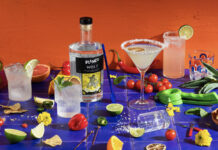Though you’ll recognize the famed whiskey name Beam, brothers Steve and Paul Beam opened their Limestone Branch Distillery in February 2012 as a completely independent craft distillery in the town of Lebanon on the Bourbon Trail Craft Tour, in tribute to their rich family heritage with similarly small distilleries going back to the 1800s.
Visiting their small, well-designed distillery just a year after opening, the brothers offered a warm, gracious welcome, showing me their 150-gallon, hand-hammered copper pot still where they produce one small batch at a time. Even Moonshiners’ star Tim Smith (timsmithmoonshine.com) was there the same day to feature their distillery.
The Beams’ great-great grandfather, Joseph Washington Dant, started distilling sour mash whiskey in the 1830’s just a few miles from Limestone Branch; and some years later, their great-grandfather Minor Case Beam distilled Old Trump and T.J. Pottinger sour mash and rye whiskeys. Post-Prohibition, grandfather Guy S. Beam was a renowned master distiller for many Kentucky distilleries. With such a distilling legacy, it is fitting that they distill on a small, hands-on scale, focusing on their Moon*Shine and Sugar*Shines.
Steve Beam shares the story behind Limestone Branch, starting the distillery with his brother Paul, answering the question, “Why moonshine?”

Tell us how your distillery began: I had been interested in starting a distillery since the early 1980’s. I began hearing about “micro distilleries” and in the Spring of 2010, I attended the ADI conference. I was convinced that the time was right to return our side of the family back to the distilling business. By September, I had begun to file the paperwork for the distillery. I convinced my brother to join me and we were off.
What led you to distilling and spirits? I come from a family that has a rich distilling history. I grew up with distillery memorabilia, including a framed family recipe, around the house. Distilling always intrigued me. My great-grandfather sold his distillery before Prohibition and I always felt it was an unfinished chapter in our history. Had we not entered into the business, we would have been the first generation since 1795 not to have been involved in the distilling industry.
Why did you decide to make moonshine? As a new distillery we needed to have a product to generate cash flow. I did not want our first product to be a purchased product. I tell people as a new distillery you have 3 basic options: vodka, gin or moonshine… depending on where you are in the country. We are in the South, so we make moonshine.
How have you grown your brand? Bottle by bottle, we have been lucky as we have had great press coverage. We have also done a tremendous amount of legwork with tastings, distributor ride-alongs, and the like.
What advice would you give to other distillers looking to get their spirits into bars? This is a difficult area to enter, one we are still experimenting with.
What is exciting you most about the current climate in spirits? Of course, bourbon. I think there is a willingness from the consumer to try experimental whiskies, which is really exciting from a distiller’s perspective. I also see the strong interest in gin as an opportunity for creative souls.








